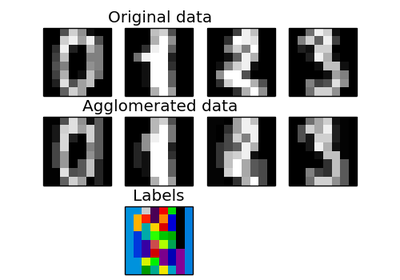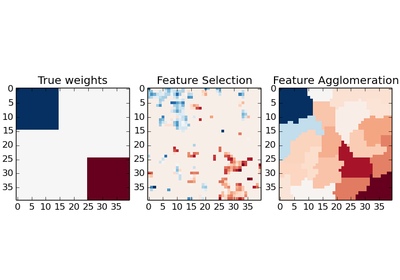sklearn.cluster.FeatureAgglomeration¶
- class sklearn.cluster.FeatureAgglomeration(n_clusters=2, affinity='euclidean', memory=Memory(cachedir=None), connectivity=None, n_components=None, compute_full_tree='auto', linkage='ward', pooling_func=<function mean at 0x2b3eef778320>)¶
Methods
fit(X[, y]) Fit the hierarchical clustering on the data fit_predict(X[, y]) Performs clustering on X and returns cluster labels. fit_transform(X[, y]) Fit to data, then transform it. get_params([deep]) Get parameters for this estimator. inverse_transform(Xred) Inverse the transformation. pooling_func(a[, axis, dtype, out, keepdims]) Compute the arithmetic mean along the specified axis. set_params(**params) Set the parameters of this estimator. transform(X[, pooling_func]) Transform a new matrix using the built clustering - __init__(n_clusters=2, affinity='euclidean', memory=Memory(cachedir=None), connectivity=None, n_components=None, compute_full_tree='auto', linkage='ward', pooling_func=<function mean at 0x2b3eef778320>)¶
- fit(X, y=None, **params)¶
Fit the hierarchical clustering on the data
Parameters: X : array-like, shape = [n_samples, n_features]
The data
Returns: self :
- fit_predict(X, y=None)¶
Performs clustering on X and returns cluster labels.
Parameters: X : ndarray, shape (n_samples, n_features)
Input data.
Returns: y : ndarray, shape (n_samples,)
cluster labels
- fit_transform(X, y=None, **fit_params)¶
Fit to data, then transform it.
Fits transformer to X and y with optional parameters fit_params and returns a transformed version of X.
Parameters: X : numpy array of shape [n_samples, n_features]
Training set.
y : numpy array of shape [n_samples]
Target values.
Returns: X_new : numpy array of shape [n_samples, n_features_new]
Transformed array.
- get_params(deep=True)¶
Get parameters for this estimator.
Parameters: deep: boolean, optional :
If True, will return the parameters for this estimator and contained subobjects that are estimators.
Returns: params : mapping of string to any
Parameter names mapped to their values.
- inverse_transform(Xred)¶
Inverse the transformation. Return a vector of size nb_features with the values of Xred assigned to each group of features
Parameters: Xred : array-like, shape=[n_samples, n_clusters] or [n_clusters,]
The values to be assigned to each cluster of samples
Returns: X : array, shape=[n_samples, n_features] or [n_features]
A vector of size n_samples with the values of Xred assigned to each of the cluster of samples.
- pooling_func(a, axis=None, dtype=None, out=None, keepdims=False)¶
Compute the arithmetic mean along the specified axis.
Returns the average of the array elements. The average is taken over the flattened array by default, otherwise over the specified axis. float64 intermediate and return values are used for integer inputs.
Parameters: a : array_like
Array containing numbers whose mean is desired. If a is not an array, a conversion is attempted.
axis : int, optional
Axis along which the means are computed. The default is to compute the mean of the flattened array.
dtype : data-type, optional
Type to use in computing the mean. For integer inputs, the default is float64; for floating point inputs, it is the same as the input dtype.
out : ndarray, optional
Alternate output array in which to place the result. The default is None; if provided, it must have the same shape as the expected output, but the type will be cast if necessary. See doc.ufuncs for details.
keepdims : bool, optional
If this is set to True, the axes which are reduced are left in the result as dimensions with size one. With this option, the result will broadcast correctly against the original arr.
Returns: m : ndarray, see dtype parameter above
If out=None, returns a new array containing the mean values, otherwise a reference to the output array is returned.
See also
- average
- Weighted average
std, var, nanmean, nanstd, nanvar
Notes
The arithmetic mean is the sum of the elements along the axis divided by the number of elements.
Note that for floating-point input, the mean is computed using the same precision the input has. Depending on the input data, this can cause the results to be inaccurate, especially for float32 (see example below). Specifying a higher-precision accumulator using the dtype keyword can alleviate this issue.
Examples
>>> a = np.array([[1, 2], [3, 4]]) >>> np.mean(a) 2.5 >>> np.mean(a, axis=0) array([ 2., 3.]) >>> np.mean(a, axis=1) array([ 1.5, 3.5])
In single precision, mean can be inaccurate:
>>> a = np.zeros((2, 512*512), dtype=np.float32) >>> a[0, :] = 1.0 >>> a[1, :] = 0.1 >>> np.mean(a) 0.546875
Computing the mean in float64 is more accurate:
>>> np.mean(a, dtype=np.float64) 0.55000000074505806
- set_params(**params)¶
Set the parameters of this estimator.
The method works on simple estimators as well as on nested objects (such as pipelines). The former have parameters of the form <component>__<parameter> so that it’s possible to update each component of a nested object.
Returns: self :
- transform(X, pooling_func=None)¶
Transform a new matrix using the built clustering
Parameters: X : array-like, shape = [n_samples, n_features] or [n_features]
A M by N array of M observations in N dimensions or a length M array of M one-dimensional observations.
pooling_func : callable, default=np.mean
This combines the values of agglomerated features into a single value, and should accept an array of shape [M, N] and the keyword argument axis=1, and reduce it to an array of size [M].
Returns: Y : array, shape = [n_samples, n_clusters] or [n_clusters]
The pooled values for each feature cluster.



